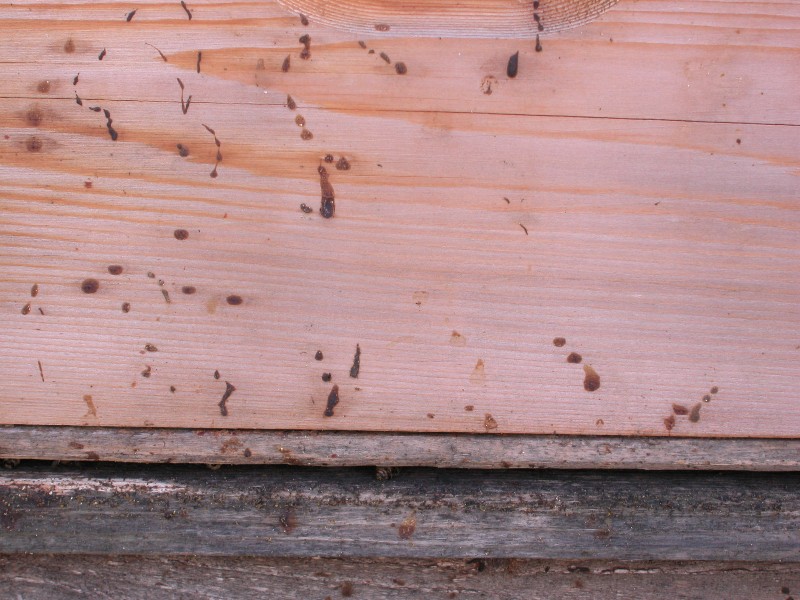Honeybee Diseases - Dysentery
Dysentery in honeybees is not so much a disease but a condition. It can develop as a result of other ailments such as Nosema, or through feeding on fermenting honey, or not being able to perform 'cleansing fights' to void their bowels. Winter dysentery problems increase if there are periods of more than two or three weeks with temperatures below 10℃. Colonies showing signs of dysentery may die out if left un-treated.
Download the Dysentery Info Sheet to obtain a printable version of Dysentery information, detection and treatment methods for your records.
Recognition
Image Courtesy The Animal and Plant Health Agency (APHA), © Crown Copyright

Dysentery up the entrance wall to the hive. Note the dark brown colour as opposed to the normal yellow.
Dysentery is more commonly a condition resulting from a combination of long periods without cleansing flights (generally due to cold weather) and food stores containing a high proportion of indigestible matter. As a bee's gut becomes engorged with faeces, the bee voids within the hive. When enough bees do this the hive population rapidly collapses and death of the colony results. Dark honeys and honeydews have greater quantities of indigestible matter. Occasional warm days during winter are critical for honeybee survival. When cleansing flights are few, bees will often be forced out at times when the temperature is barely adequate for their wing muscles to function, and large quantities of bees may be seen dead in the snow around the hives. Colonies that are found dead in spring from dysentery will have the tell-tale feces smeared over the frames and other hive parts. In very cold areas where no cleansing flights are possible during the coldest spells of winter, it is possible to replace all honey from the hives with a high fructose corn syrup which has nearly no indigestible matter thereby reducing the need for 'cleansing flights'.
Detection
Hive Examination - Examination of the hive fronts and entrance area, brood frames and floor debris is required especially in winter and spring months. Bees should be gently shaken from the frames to allow full inspection, abnormalities are then easily spotted.
Monitoring - Vigilance is important with all honeybee diseases. Check all apiaries and colonies regularly for health and suspect any colonies that are not thriving where there is no already known reason. Ensure appropriate feeding prior to and during winter months. Colonies that are not performing well or die out should be examined thoroughly and sealed to prevent robbing and spread of any diseases present.
Treatment
The is no medical treatment for Dysentery, prevention is best practice, maintain good apiary housekeeping and bee husbandry:
- Always maintain strong and vigorous colonies that show good hygienic tendencies, re-queen from known healthy colonies.
- Always maintain a high level of hygiene in all your beekeeping practices
- Carry out methodical health inspections on a regular basis, checking for brood disease particularly in spring and autumn.
- Never transfer combs between colonies without checking for brood diseases
- Systematically replace old brood combs in your hives melting down the old comb to maintain clean and healthy brood.
- Never bring colonies or equipment into your apiary without establishing their origin, condition, and disease status.
- Sterilise any secondhand equipment or hive components before introducing them into your apiary
- Discourage drifting and robbing in the apiary
- Suspect stray swarm health until you know otherwise
- Report any incidence of disease or suspicious conditions immediately to your local association
Vectors
Prolonged periods of cold weather (more than 2 weeks at less than 10℃) hindering 'cleansing flights'.
- Old fermenting honey stores in hive.
- Where Nosema is suspected as the cause - spores can exist in beekeeping equipment, honey, wax, etc. and will spread quickly during normal hive / colony manipulations.
- Beekeepers - Transferring contaminated equipment / material between hives, colonies and apiary sites.
- Crushed Bees - Bees will clean up any crushed bees during normal house keeping activities and can pick up and spread spores quickly through the colony.
- Robbing - Colonies weakened by other ailments will fall prey to robbing, transferring spores to other colonies and apiaries.
- Drifting - As with Robbing will transfer spores to other colonies.
- Swarming - Swarms can carry the spores with them to new sites where the disease will spread once new brood is produced.
Try the Honeybee Diseases Quiz
About the 'My Beekeeping Kit' website.
Contact Iain Dewar for enquiries, suggestions, corrections and contributions for improving the notes. Always welcome!